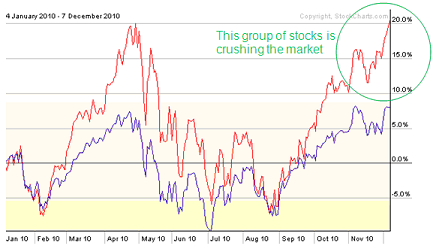There is one group of stocks that's absolutely crushing the market this year. Since the beginning of the year, this sector of the market is up 20 percent, versus around a 7.5 percent return from the S&P 500.

Usually, to beat the market in a big way investors assume they need to take on undue risk, or buy highly speculative stocks that have a real possibility of seeing their share values get cut in half on one bad news announcement.
Not so with this group of stocks. Investors can buy this diverse group of
stocks by entering one simple order with their broker. And I have four
potential ways you can play the trend, so in fact there are even more
diversification options within this sector for investors who don't like
to buy just one security.
***The group of stocks I'm talking about? Micro-cap stocks. Typically defined as companies with market caps below $1 billion, these little companies have the greatest exposure to a growing economy since they are usually nimble and can generate huge returns on invested capital - if management makes wise decisions.
These companies do come with some inherent risk however. They tend to have less cash on hand, and with smaller customer bases they are exposed to economic downturns. But right now, with a double-dip recession essentially off the table and a very low interest rate environment, these companies are enjoying growth that far outpaces many of their larger competitors.
***There are four ways for investors to gain exposure to a basket of micro-cap stocks by either buying an exchange traded fund (ETFs) or a mutual fund. Each takes a slightly different approach to their stock selection criteria.
iShares Russell Microcap ETF (NYSE: IWC): This fund was started in 2005 and would be my first choice of the four. With an expense ratio of 0.71% the cost of ownership is in line with the three other options below, but its performance generally outpaces the others in this group. The fund holds the smallest 1,000 stocks in the Russell 2000 small-cap stock index, as well as the next 1,000 smallest companies covered by the Russell indices. Truth be told, a lot of the companies in this index are not 'true' micro-caps since their market caps are a tad high, but with wide exposure the fund provides a good single security option for investors looking to tap into a strong sector.
Bridgeway Ultra-Small Company Market (BRSIX): Bridgeway's management uses a quantitative model that strives to keep companies with poor fundamentals out of the fund. While I like this approach, lately a lot of poor fundamental companies have seen their stocks soar as investors have taken on more risk. Consequently, this fund's performance has lagged. The fund has an expense ratio of 0.77%, and tries to emulate the return of the Cap-Based Portfolio 10 Index which is published by the University of Chicago's Center for Research in Security Prices.
First Trust Dow Jones Select MicroCap ETF (NYSE: FDM): This fund strives to replicate the returns of the Dow Jones Select Microcap Index and favors strong fundamentals such as price to earnings ratio and price to sales ratio, as well as liquidity, over other metrics. The net expense ratio is 0.60%.
PowerShares Zacks Micro Cap ETF (NYSE: PZI): This ETF is a bit odd in my opinion in that the fund's prospectus states that it is '...based on the Zacks Micro Cap Index', and that 90 percent of total assets are in that index. I don't follow this index, so it is a bit meaningless to me. However, fund holdings are available for viewing on the company's website, and with an expense ratio of 0.70 percent the fund is not overly expensive to own.
***Of course where the rubber hits the road with these funds is their individual performance and despite their exposure to small companies posting big returns this year there are significant differences between the funds over the last year.

The IWC has clearly outperformed, and in my opinion is the best option of the group. I've looked at the returns of these four funds over a longer duration, and this fund, along with the FDM, have tended to both post higher gains, as well as hold their value better than the other two.
***The strong move in micro-cap stocks should key
investors in to the benefits of exposure to small, high-growth companies.
As always, don't put all your eggs in one basket, and make sure your
investments match up with your particular risk profile.
Let me know if you have any questions about these funds, their holdings,
or their investment strategies. My address is: editorial@smallcapinvestor.com.
Editor's Note: Why do the Biggest Gains ALWAYS Come from Micro-Cap Stocks? Follow the link to find out why, and learn more about the strategy we use to find small and micro-cap stocks, like two that have risen 110 percent and 90 percent since our recommendation date.
© 2025 Benzinga.com. Benzinga does not provide investment advice. All rights reserved.
Trade confidently with insights and alerts from analyst ratings, free reports and breaking news that affects the stocks you care about.